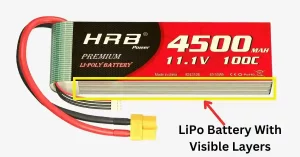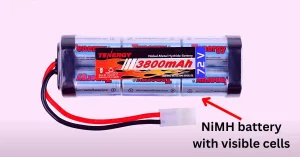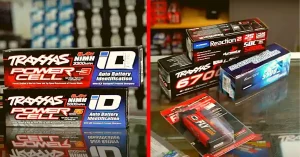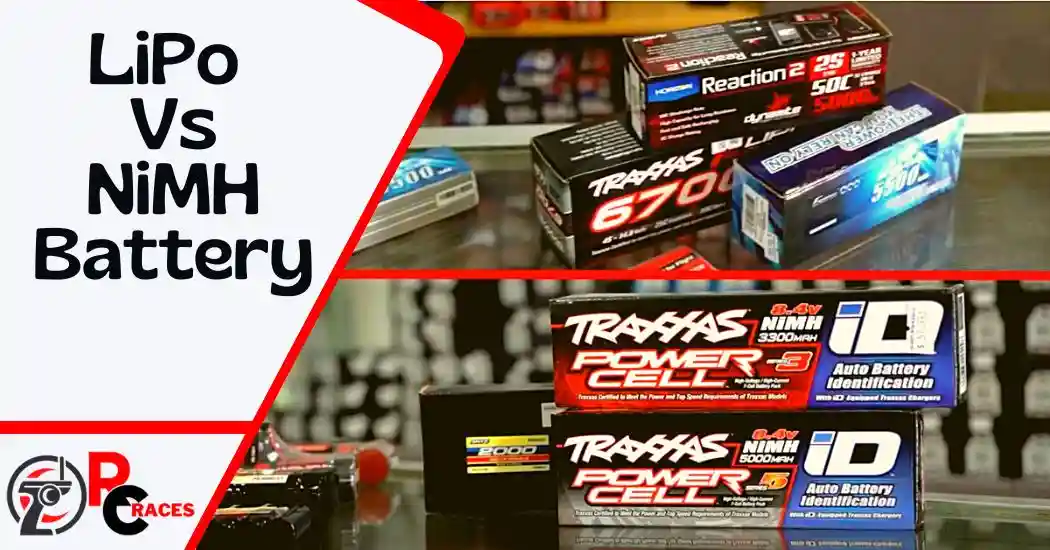In the comparison between LiPo and NiMH batteries, LiPo takes the first position for providing high power output and NiMH wins for an overall longer lifespan. Both batteries have unique characteristics that make them well-suited for particular usage.
In this article, we will compare both batteries, reveal their strength and weakness and finally discover the best one for a user with specific needs.
Read and enjoy!
Comparison between LiPo and NiMH
The chart shows direct comparisons between these two battery types. You can check their factors at a glance and pick the right one for you.
Factors | LiPo batteries | NiMH batteries |
Voltage | Higher voltage per cell. | Lower voltage per cell. |
Energy density | High. | Moderate. |
Discharge rate | High. | Low. |
Applications | For high power RCs. | For low-power RCs. |
Charging cycle | 150 to 300. | 300 to 450. |
Performance | High power output. | Moderate power output. |
Weight and size | Lightweight and compact. | Heavy and bulkier. |
Charging time | Faster. | Slower. |
Charging process | More complex. | Very simple. |
| Safety | Risk of fire hazards. | Comparatively safer. |
| Cost | Relatively costlier. | Cost-effective. |
After the quick evaluation, we are going to compare both batteries in detail. Read the following sections for more comparative information about LiPo and NiMH batteries.
LiPo Batteries Overview
Lithium Polymer, also known as LiPo battery, is a rechargeable power source for RC vehicles. They have solid polymer electrolytes to transfer lithium ions between the positive and negative electrodes.
LiPo battery’s construction has layers of electrodes and separators. These layers are rolled into a cylindrical structure to make a usable shape. The particular structure also maximizes the surface area, enhances the lithium-ion movement and boosts the energy density.

Components of LiPo battery:
- Electrodes: Two electrodes, usually made of a thin metal foil coated with active materials.
- Separator: A thin polymer separator that prevents direct contact and short circuits between electrodes.
- Electrolyte: A gel-like substance that contains lithium ions.
- Current collectors: Thin metal foils that act as electrode collectors.
- Protective casing: Made of a flexible polymer film, it protects the internal components and prevents moisture.
- Terminal: Two terminals—one positive (+) and one negative (-), connects to external devices or charging circuits.
Key characteristics of LiPo battery:
- LiPo batteries have a high energy density per unit, requiring less frequent recharging.
- They have a compact design comparing other rechargeable batteries and are lightweight.
- They have a high discharge rate, meaning a LiPo battery provides a large amount of current in a short time.
NiMH Batteries Overview
Nickel-Metal Hydride, or NiMH, is also a common rechargeable battery for RC vehicles. They are well-known as low-power RC cars’ energy sources.
The construction of NiMH batteries involves the assembly of positive and negative electrodes and a separator. They are folded into a compact shape and the structure is placed inside a casing for the battery’s safety and integrity.

Components of NiMH battery:
- Positive Electrode: Made of nickel hydroxide (NiOOH) active material, it acts as a current collector.
- Negative Electrode: a mixture of metal hydrides, is the active material for storing and releasing hydrogen ions during charging and discharging.
- Separator: Placed between the positive and negative electrodes to prevent direct contact and short circuits.
- Electrolyte: Help transport hydroxide ions (OH-) between the positive and negative electrodes during the battery’s operation.
- Casing: Made of metal or plastic to provide physical support and prevent external damage to the battery.
- Terminal: One positive (+) and one negative (-) terminal for connecting the battery to external devices or charging circuits.
Key characteristics of NiMH battery:
- NiMH batteries have high energy storing capacity, providing longer operation periods than other battery types.
- They are recyclable and more environmentally friendly than other battery chemistries.
- They have higher charge and discharge cycles, suitable for appliances requiring frequent recharging.
Performance Comparison Between LiPo And NiMH Batteries
LiPo and NiMH are two different types of batteries. But they are designed for the same purpose, to be used as the power source of RC cars. Let’s check out their performance comparison.
A. Capacity and voltage
LiPo batteries have more energy-storing capacity per unit compared to NiMH. Thus, it can provide you longer runtime. LiPo also has a higher nominal voltage per cell.
B. Power output and runtime
Because of the high discharge rate, LiPo batteries provide a very powerful output compared to NiMH. They also maintain stable voltage and ensure consistent power until the end of the battery life.
In contrast, NiMH batteries are good at higher energy capacity. But they do not provide power output like LiPo batteries.
C. Weight and size
LiPo batteries are lightweight. They also have a compact design suitable for appliances like RC cars, where size and weight play a crucial role. On the other hand, NiMH batterie is heavier and bulkier, which can affect the performance of RC vehicles.
D. Discharge characteristics
LiPo batteries maintain higher voltage levels throughout their discharge cycle. Thus, the user gets consistent power output. In contrast, NiMH batteries drop the voltage slowly as they discharge. However, the remaining battery capacity is more predictable.
Application and Usage of LiPo and NiMH Batteries
These two types of batteries are known for their different applications and uses. LiPo batteries provide impressive power, whereas NiMH is an excellent budget-friendly energy source.

LiPo batteries are the best choice for the following usage.
1. High-performance applications:
Due to high power and discharge rates; LiPo batteries are particularly relevant to powerful appliances like RC cars. Their high discharging rate ensures quick acceleration and impressive speed of RC vehicles. Moreover, they provide high power to the motor for outstanding performance.
2. Competitive racing:
LiPo batteries are reliable power sources for RC vehicles in competitive racing. They offer a high power-to-weight ratio which is ideal for faster acceleration, higher top speed and excellent agility.
These batteries also have a fast charging facility, a crucial feature in emergencies. Longer run time is another characteristic of LiPo batteries that makes them desired during racing.
NiMH batteries, on the other hand, are ideal for the below applications.
1. Budget-friendly options:
NiMH batteries are an attractive power source for RC enthusiasts needing cost-effective power solutions. Compared to LiPo or Li-ion, they are more affordable and suitable for low-power electric RC vehicles.
These batteries come with more charge cycles than other types of batteries. As a result, they save users’ costs by reducing frequent battery replacements.
2. Casual or recreational use:
NiMH batteries are ideal power sources for casual RC cars or models requiring low discharge rates. This characteristic makes the battery affordable and efficient for low-power RCs and other small electric appliances.
Charging Requirements for LiPo and NiMH Batteries
The charging requirements of LiPo and NiMH batteries are noticeably different. Here are two charts showing the unique specifications of both batteries.
Lithium-Polymer battery (LiPo):
LiPo batteries have fewer charging cycles, around 150 to 300. They have a very complex charging process compared to other batteries. Check out the LiPo charging requirements below.
| Charging voltage | Up to 4.2 volts per cell |
| Charging current | 1C |
| Multi-cell charging | Balance charging technology |
| Charger features |
|
Nickel Metal Hydride battery (NiMH):
NiMH batteries have more charging cycles, around 300 to 450. The charging process of NiMH is simple and straightforward. Check out the NiMH charging requirements below.
| Charging voltage | 1.2 volts per cell |
| Charging current | 0.3-0.5C |
| Charging termination | Delta V (ΔV) |
| Charger features |
|
Which Is The Right Choice For You?
LiPo and NiMH batteries have very specific uses. But if you are in a dilemma while choosing one for your RC vehicle, the following points will directly indicate the right one for you.
You should go for LiPo battery if:
- You have a high-performance RC vehicle like a high-speed car or drone.
- You prioritize speed, acceleration, and extended runtime.
- You need higher energy density and a longer overall lifespan.
- You are looking for a cost-effective power source in the long run.
You should go for a NiMH battery if:
- You have casual or entry-level RC vehicles.
- Your RCs don’t require extreme power or speed.
- You value longer overall runtime without requiring peak performance.
- You need a budget-friendly power source.
Frequently Asked Questions
How do LiPo and NiMH batteries affect the performance of RC vehicles?
Due to high power output, LiPO batteries offer RC cars excellent acceleration and top speed. In contrast, NiMH batteries provide moderate power output but longer runtime.
What other rechargeable batteries are commonly used in RC vehicles?
Along with LiPo and NiMH, NiCd, Lead-acid and Zinc-carbon batteries are widely used in RC vehicles.
Which is more suitable, LiPo or NiMH, for beginners?
NiMH batteries are more suitable for beginners as they are easier to handle. They have less risk of damage and fire accident during charging. NiMH is also more budget-friendly and offers longer runtime.
Final Words
When you have both options, choose between LiPo and NiMH carefully based on your precise needs. A good practice before picking a battery for your RC vehicle is to note your specific requirements. After that, match the battery’s specifications and your requirements to make a well-informed decision. The ideal type of battery will last longer and maximize your RC’s performance.


